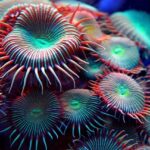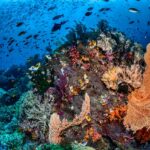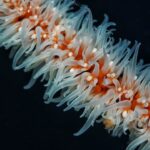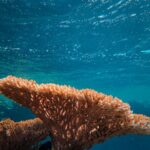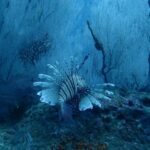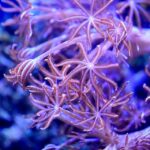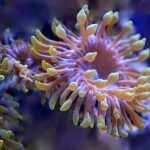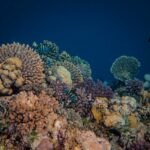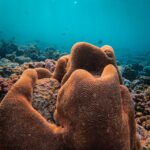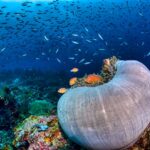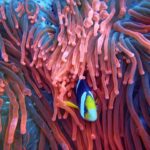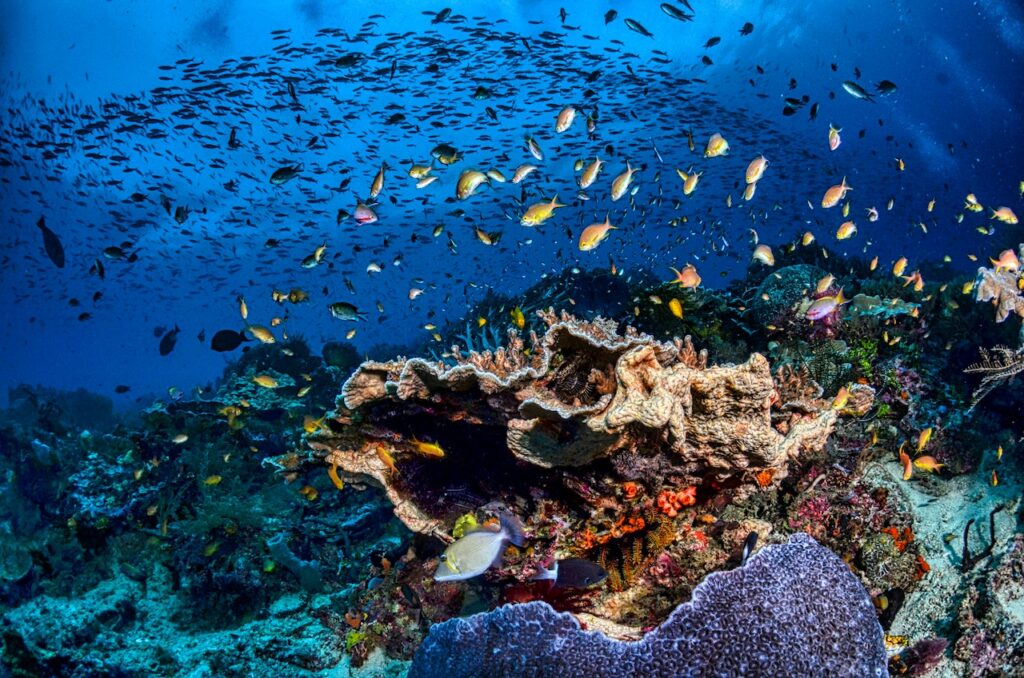

25% of marine life is connected to coral reefs
Diversity of corals
Corals are marine invertebrates that form intricate structures, providing habitats for marine life. They have a symbiotic relationship with photosynthetic organisms like algae. When we say “coral,” we’re talking about groups of small animals that band together. You can find them in the mysterious depths of the ocean or close to the shoreline. Corals at the shoreline form coral reefs that play a crucial role in supporting all kinds of marine life. Coral reefs serve as the largest homes and bustling hubs for marine creatures to reproduce.
Coral reefs hold significance for human societies in numerous ways. Economically, they support vibrant industries such as tourism, fishing, and pharmaceutical research. Coastal communities benefit from the protection provided by coral reefs against erosion and storm damage, acting as natural barriers that mitigate the impacts of tropical storms and hurricanes. Coral reefs soak up a remarkable 97% of ocean waves.
Coral reefs are predominantly found around the coasts of Australia and Asia. Sadly, approximately half of these reefs have disappeared over the past three decades. What’s even more concerning is that 75% of the reefs that are left are currently under threat. Experts predict that if the current trends continue, as much as 90% of the remaining coral reefs could be in danger by the year 2050.
Coral reefs are vulnerable to changes in their environment. Stony corals require carbon and calcium to create their distinct shapes which we find amusing. However, due to climate change, the increasing acidity of the water results in reduced carbon levels. As a result, all marine life relying on carbon to build their shells or bones face challenges. For them, it’s a matter of adapting or facing dire consequences. Coral bleaching is a primary challenge that coral reefs encounter as a result of warming ocean temperatures.
What is coral bleaching?
Coral bleaching is a phenomenon that occurs when coral reefs, which are normally vibrant and colorful due to the presence of tiny algae called zooxanthellae, lose their coloration. These algae live within the coral tissues and have a symbiotic relationship with the corals. They provide essential nutrients through photosynthesis and contribute to the vivid colors of the corals. Thanks to these algae the corals can create proteins, and carbohydrates, and produce calcium carbonate.
However, when corals experience stressful environmental conditions, such as unusually high water temperatures, pollution, or increased acidity due to climate change, they expel the algae from their tissues. This expulsion results in the loss of color, giving the corals a bleached appearance. Coral bleaching weakens the corals and makes them more vulnerable to disease outbreaks and other stressors. If the stressors persist or worsen, the corals may eventually die. Mass coral bleaching events, where large portions of a reef experience bleaching simultaneously, can have devastating effects on entire ecosystems that depend on coral reefs for food, shelter, and other ecological services.
What are coral reefs?
Contrary to common belief, coral isn't a plant, but a collection of tiny animals equipped with a mouth and stomach. These creatures typically feed at night by using stinging mechanisms to catch their prey. The coral reefs you see along the beach are the ones that lie near the surface of the sea. Picture the scenes from the movie Finding Nemo, where the clownfish live among these coral reefs.
What is coral bleaching?
Coral bleaching is the expulsion of symbiotic algae from coral, causing the coral to lose color and eventually leading to its decline or death due to stress, primarily from high water temperatures.
Why are coral reefs a climate tipping point?
Coral reefs are climate tipping points due to their sensitivity to temperature changes, potentially triggering widespread ecosystem collapse and biodiversity loss.
What do we do to protect coral reefs?
Efforts to mitigate coral bleaching include reducing carbon emissions to mitigate climate change effects, establishing marine protected areas, and implementing conservation measures to minimize other stressors on coral reefs. Even bleached coral colonies can be saved. Remarkable scientists from NOAA are diligently working to restore reefs, though the process is gradual and labor-intensive.

tiny plankton have a mayor impact
What are plankton?
Plankton constitutes a diverse group of microorganism species. Plankton encompasses organisms that have limited self-movement. Among these are jellyfish, bacteria (Cyanobacteria), algae (Zooxanthellae), plants, and small animals. Many of these organisms are situated along the coastlines near the equator and are responsible for a substantial portion of oxygen production.
Why is plankton so important?
Approximately 50% of the Earth’s oxygen is generated through photosynthesis by marine plants and phytoplankton. Phytoplankton, in particular, play a pivotal role in mitigating atmospheric CO2 and its associated warming effects.
Phytoplankton occupy the foundation of the marine food chain and serve as a primary source of sustenance for corals. They provide essential support for the entirety of marine life by shaping ecosystems such as reefs and deep-sea habitats. The marine life cycle, food supply, decomposition, and oceanic purification all depend on the role of phytoplankton. Plankton are integral components of marine food webs, serving as primary producers and primary prey for various marine organisms. Climate change-induced shifts in plankton populations can cascade through the food chain, affecting fish, marine mammals, and even seabirds that rely on plankton as a food source.
What are plankton
Plankton are diverse microscopic organisms that drift in water bodies, comprising phytoplankton (photosynthetic) and zooplankton (consumers). Serving as a crucial foundation of aquatic food chains, they play a vital role in global nutrient cycling and oxygen production. Plankton's small size allows them to be carried by currents, impacting marine ecosystems and climate dynamics.
What are phytoplankton?
There are two groups: Zooplankton and phytoplankton.
Zooplankton are organisms that primarily feed on other planktonic organisms, such as phytoplankton or smaller zooplankton. They are a vital link in the marine food chain, as they transfer energy from lower trophic levels to higher trophic levels, supporting the entire aquatic ecosystem.
Phytoplankton converts sunlight, carbon dioxide, and nutrients (such as nitrogen and phosphorus) into organic matter. This organic matter serves as food for other organisms in the ecosystem, starting the food chain.
How does temperature effect plankton?
Plankton are vulnerable to the impacts of climate change due to their sensitivity to shifts in temperature, ocean acidity, and nutrient availability. Plankton thrives within specific temperature ranges, as their metabolic processes and growth rates are intricately linked to water temperatures. For some species, higher temperatures might accelerate their metabolism, reducing their ability to acquire nutrients and reproduce effectively.
How does acidification effect plankton?
Acidification affects the availability of carbonate ions, which are essential for the formation of calcium carbonate shells and skeletons in some plankton species, particularly those with calcareous structures. Plankton requires various nutrients such as nitrogen, phosphorus, and iron for growth and reproduction. Changes in ocean circulation patterns and warmer waters can lead to decreased nutrient upwelling from deeper ocean layers, impacting the nutrient supply at the surface where plankton thrive.
How does UV effect plankton?
Rising sea levels, driven by melting ice and warmer temperatures, can alter coastal ecosystems. Coastal plankton populations can be affected by changes in shoreline dynamics, increased sedimentation, and altered light penetration, all of which can disrupt their habitats and food sources. Solar radiation, including UV light, facilitates photosynthesis. UV light breaks down molecules of dissolved organic carbon (DOC), contributing to clearer ocean waters and enhanced penetration of solar UV. However, this feedback mechanism operates both ways. Excessive UV exposure can lead to the destruction of plankton molecules.
What are plankton bloom?
When conditions are favorable, such as when there's an excess of nutrients (like nitrogen and phosphorus), warm temperatures, and ample sunlight, phytoplankton can reproduce rapidly. This results in a sudden increase in their numbers, leading to a visible discoloration of the water. The water might appear green, brown, red, or even other colors depending on the types of phytoplankton involved. Plankton blooms have a negative impact on aquatic biodiversity.
Is plankton an climate tipping point or keystone species?
We have chosen to dedicate a section to plankton, even though they are not officially categorized as keystone species or climate tipping points. Plankton offer insights into the dynamics of water warming, acidification, nutrient levels, and chemical balance. They also can have an impact on CO2 levels and might indirectly signal changes in UV radiation. Including a section on plankton enables us to explore these aspects further in our upcoming project.
The consequences of plankton
Disruptions in phytoplankton population levels, whether due to under- or overpopulation, can result in increased CO2 concentrations. Polar regions, which also harbor plankton species, are experiencing rapid warming and ice melt due to climate change. The water warming can create plankton blooms, which have significant impacts on the entire Arctic and Antarctic food webs.
The disappearance or excessive proliferation of plankton can lead to significant ecological disruptions. Overpopulation might result in sun blockage for other species, while their absence can disrupt the ecological balance by affecting nutrient availability and chemical equilibrium. The chemical balance of the ocean, critical to sea and air currents, is partly controlled by phytoplankton. They represent a foundational element within the Earth’s systems, and their decline could precipitate a global extinction event.
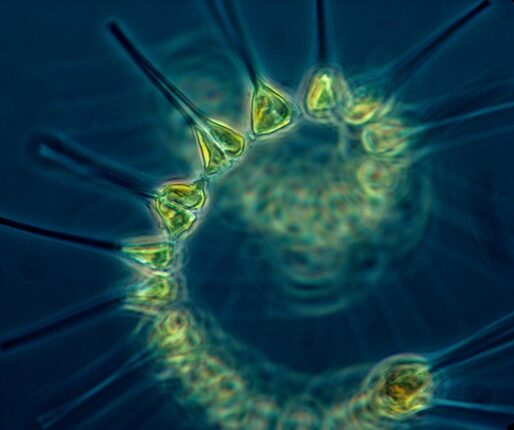

Starfish are the first keystone species
Wat are starfish?
These creatures inhabit oceans around the world, from shallow coastal waters to deep ocean floors. Starfish are predators and scavengers, feeding on a variety of prey such as small fish, mollusks, and detritus. By controlling the populations of these prey species, sea stars prevent them from becoming dominant and out-competing other species. This allows for greater species diversity within the ecosystem.
Why are starfish keystone species?
When sea stars are removed from an ecosystem, unchecked populations of their prey can lead to altered habitat structures and reduced overall diversity. A famous examples of sea stars as keystone species is the case of the “sea star wasting disease.” This disease caused massive die-offs of sea stars along the west coast of North America. In its absence, populations of its prey, such as sea urchins, exploded. These sea urchins, in turn, overgrazed kelp forests, leading to a decline in the health and biodiversity of the entire ecosystem. The loss or decline of sea star populations can lead to significant ecological imbalances, affecting the entire food web and community structure.
What are starfish?
A starfish, also known as a sea star, is a marine invertebrate that often has a five-armed, star-shaped appearance. Despite their common name, starfish are not fish; they are part of the phylum Echinodermata ("spiny skin"), which includes other creatures like sea urchins, sea cucumbers, and sand dollars.
fun facts about starfish
Starfish use a unique water vascular system to move and capture prey. This system consists of a network of fluid-filled canals and tube feet. By controlling the pressure of water within these canals, starfish can extend and retract their tube feet, allowing them to move, attach to surfaces, and manipulate their environment.
One remarkable feature of starfish is their ability to regenerate lost body parts. If a starfish loses an arm due to predation or injury, it can often regrow the lost arm over time. In some cases, if a severed arm retains a portion of the central disc, it can even regenerate into a whole new starfish.
Do starfish also eat coral?
No, starfish don't have coral reefs on their menu. Only a few starfish species can feed on the polyps that form the coral structure. Some crown-of-thorns starfish (Acanthaster spp.) are known for their ability to feed on corals. These sea stars can cause damage to coral reefs by consuming coral polyps. When populations of crown-of-thorns starfish increase beyond their normal levels, they can lead to coral predation that contributes to coral reef degradation.
Why is starfish a keystone species?
Paine termed the sea star a "keystone species" because its influence on the ecosystem was disproportionate to its abundance, much like the keystone in an arch supports the entire structure.
Starfish are the first keystone species
Robert T. Paine was an ecologist who conducted pioneering research on the concept of keystone species and their role in maintaining ecological balance and diversity in ecosystems.
He focused on the interactions among species in this ecosystem, particularly the relationship between purple sea stars (Pisaster ochraceus) and other organisms such as mussels (Mytilus californianus). Paine’s research demonstrated that the removal of keystone species like sea stars could lead to significant shifts in species composition and ecosystem structure. Without the purple sea stars, mussels would dominate the intertidal zone, excluding many other species and reducing overall biodiversity.
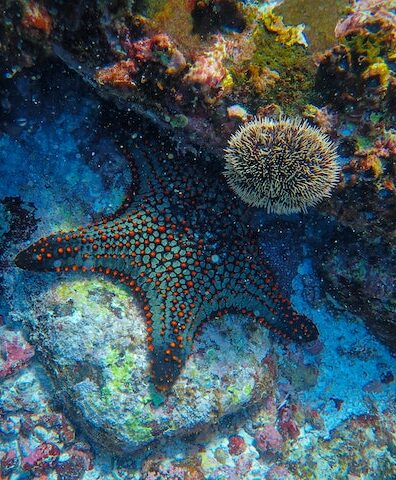
Potential danger
- Less water that is safe to drink
- Risk for the extinction of marine life
- Health hazard from Blue-green-algae
- Increase in Co2 and methane
- Thinning of the ozone layer
- Warming of the planet
- Turning oceans from mediators into accelerators for climate change
Solutions
To safeguard coral reefs, a combination of strategies is crucial. Marine Protected Areas (MPAs) should be established and effectively managed to restrict harmful activities like overfishing and pollution. Moreover, coral restoration initiatives can aid in reviving damaged reefs and enhancing their resilience. Encouraging sustainable fishing practices and implementing measures to reduce pollution from land sources are pivotal steps in preserving the health of coral reef ecosystems.
Tackling climate change remains paramount to counteract the effects of warming seas on plankton populations. Continuous research and monitoring efforts will help in comprehending the behavior of plankton in response to changing environments and their potential impacts on marine ecosystems.
Conservation of biodiversity and early detection mechanisms are crucial in preventing the overpopulation of starfish and maintaining the equilibrium of marine habitats. Collaboration between various stakeholders is imperative to ensure the success of these approaches in preserving our marine ecosystems.
Sources and credits
Your Suggestions Welcome
Marine Species in the Spotlight
Do you know of a marine species that deserves recognition on this page? (Potential climate tipping point or keystone species?) We value your insights, and your contribution could help us expand our coverage of marine diversity.

